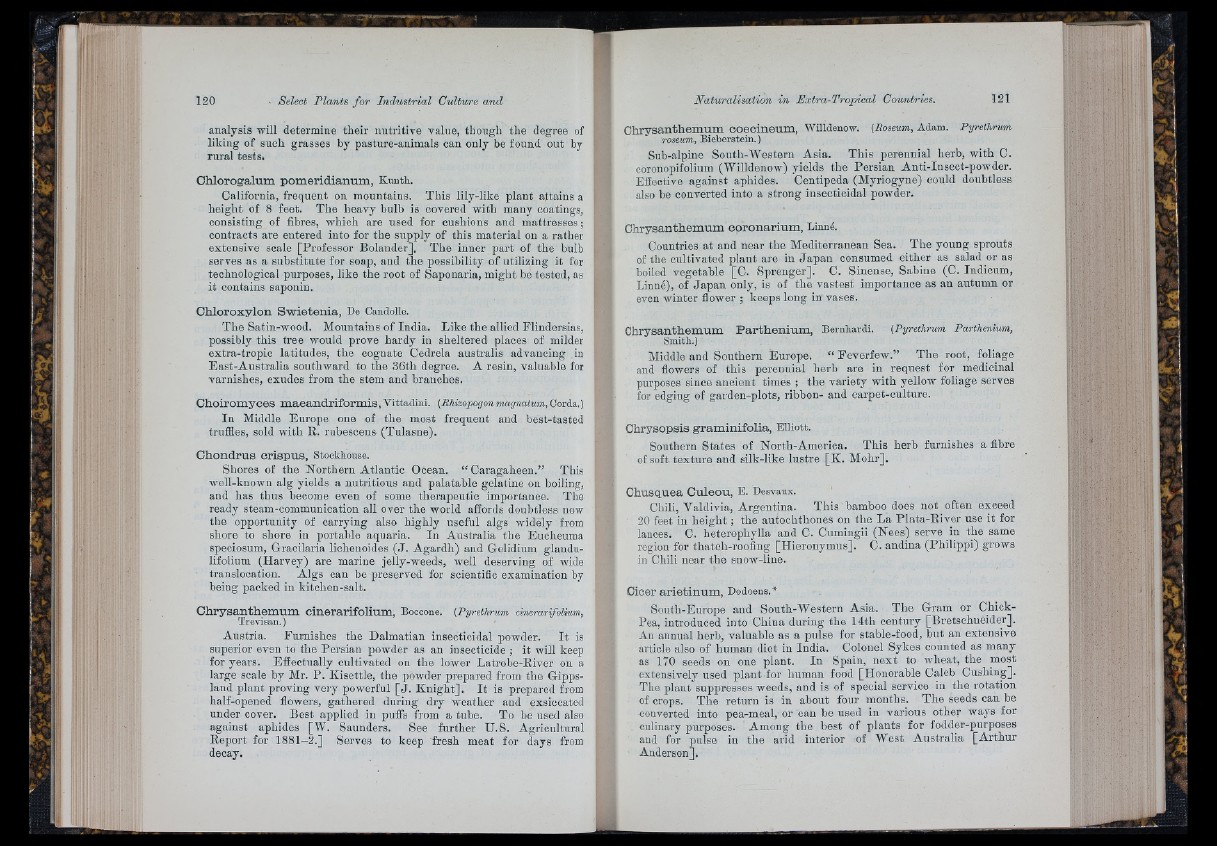
analysis will determine their nutritive value, though the degree of
liking of such grasses by pasture-animals can only be found out by
rural tests.
C h lo ro g a lum p o m e r id i a n u m , Kuuth.
California, frequent on mountains. This lily-like plant attains a
height of 8 feet. The heavy bulb is covered with many coatings,
consisting of fibres, which are used for cushions and mattresses;
contracts are entered into for the supply of this material on a rather
extensive scale [Professor Bolander]. The inner part of the bulb
serves as a substitute for soap, and the possibility of utilizing it for
technological purposes, like the root of Saponaria, might be tested, as
it contains saponin.
O h lo ro x y lo n S w ie t e n i a , De Candolle.
The Satin-wood. Mountains of India. Like the allied Fliudersias,
possibly this tree would prove hardy in sheltered places of milder
extra-tropie latitudes, the cognate Cedrela australis advancing in
East-Australia southward to the 36th degree. A resin, valuable for
varnishes, exudes from the stem and branches.
C h o irom y c e s m a e a n d r i f o rm is , Vittadini. {Shizopogon magnatum, Gorda.)
In Middle Europe one of the most frequent and best-tasted
truiHes, sold with E. rubescens (Tulasne).
C h o n d r u s c r is p u s , Stockhouse.
Shores of the Northern Atlantic Ocean. “ Caragaheen.” This
well-known alg yields a nutritious and palatable gelatine on boiling,
and has thus become even of gome therapeutic importance. The
ready steam-communication all over the world affords doubtless now
the opportunity of carrying also highly useful algs widely from
shore to shore in portable aquaria. In Australia the Euoheuma
speciosum, Gracilaria lichenoides (J . Agardh) aud Gelidium glandu-
lifolium (Harvey) are marine jelly-weeds, well deserving of wide
translocation. Algs can be preserved for scientific examination by
being packed in kitchen-salt.
C h r y s a n th em u m c in e r a r if o lium , Boccone.
Trevisan. )
(Pyrethrum einerarifoUum,
Austria. Furnishes the Dalmatian insecticidal powder. I t is
superior even to the Persian powder as an insecticide ; it will keep
for years. Effectually cultivated on the lower Latrobe-River on a
large scale by Mr. P. Kisettle, the powder prepared from the Gipps-
iand plant proving very powerful [ J . Knight]. I t is prepared from
half-opened flowers, gathered during dry weather and exsiccated
under cover. Best applied in puffs from a tube. To be used also
against aphides [W. Sannders. See further U.S. Agricultural
Report for 1881-2.] Serves to keep fresh meat for days from
decay.
C h r y s a n th em um c o e c in e um , Willdenow. (Roseum, Adam. Pyrethrum
roseum, Bieberstein.)
Sub-alpine South-Western Asia. This perennial herb, with C.
coronopifolium (Willdenow) yields the Persian Anti-Insect-powder.
Effective against aphides. Centipeda (Myriogyne) could doubtless
also be converted into a strong insecticidal powder.
C h r y s a n th em um c o r o n a r iu m , Linné.
Countries at and near the Mediterranean Sea. The young sprouts
of the cultivated plant are in Jap an consumed either as salad or as
boiled vegetable [C. Sprenger], C. Sinense, Sabine (C. Indicum,
Linné), of Japan only, is of the vastest importance as an autumn or
even winter flower ; keeps long in vases.
l ì
C h r y s a n th em um
Smith.)
P a r t h e n i u m , Bernhard!. (Pyrethrum Parthenium,
Middle and Southern Europe. “ Feverfew.” The root, foliage
and flowers of this perennial herb are in request for medicinal
purposes since ancient times ; the variety with yellow foliage serves
for edging of garden-plots, ribbon- and carpet-culture.
C h ry so p s is g r am in i f o li a , Elliott.
Southern States of North-America. This herb furnishes a fibre
of soft texture and silk-like lustre [K . Mohr].
C h u sq u e a C u le o u , E. Desvaux.
Chili, Valdivia, Argentina. This bamboo does not often exceed
20 feet in height ; the autochthones on the La Plata-River use it for
lances. 0 . lieterophylla and C. Cumingii (Nees) serve in the same
region for thatch-roofing [Hieronymus]. C. andina (Philippi) grows
in Chili near the snow-line.
Cicer a r ie tin u m , Dodoens.*
South-Europe and South-Western Asia. The Gram or Chick-
Pea. introduced into China during the 14th century [Bretsohueider].
An annual herb, valuable as a pulse for stable-food, but an extensive
article also of human diet in India. Colonel Sykes counted as many
as 170 seeds on one plant. In Spain, next to wheat, the most
extensively used plant for human food [Honorable Caleb Cushing].
The plant suppresses weeds, and is of special service in the rotation
of crops. The return is in about four months. The seeds can he
converted into pea-meal, or can be used in various other ways for
culinary purposes. Among the best of plants for fodder-purposes
and for pulse in the arid interior of West Australia [Arthur
Anderson].